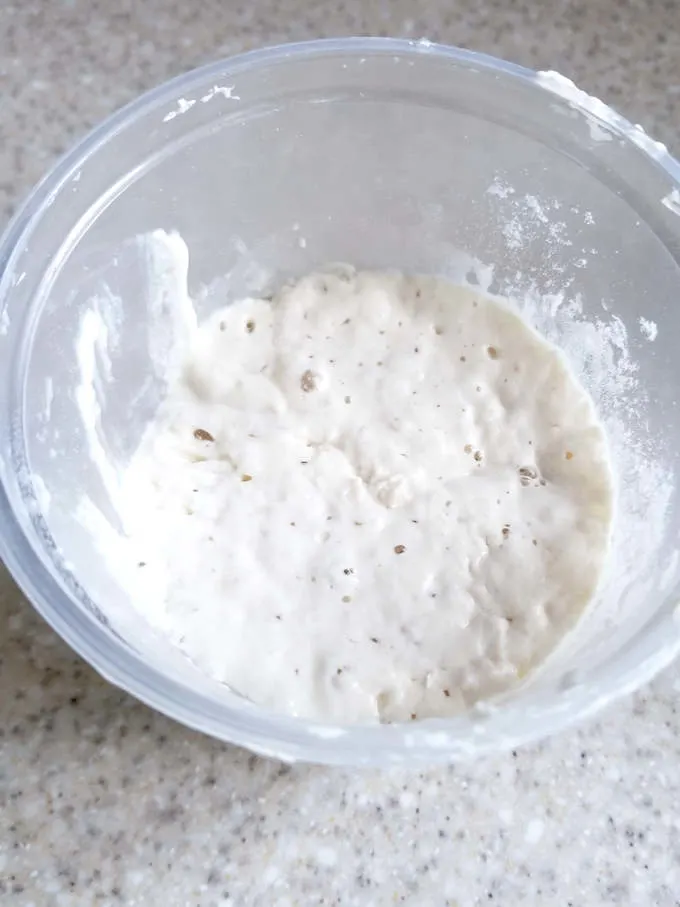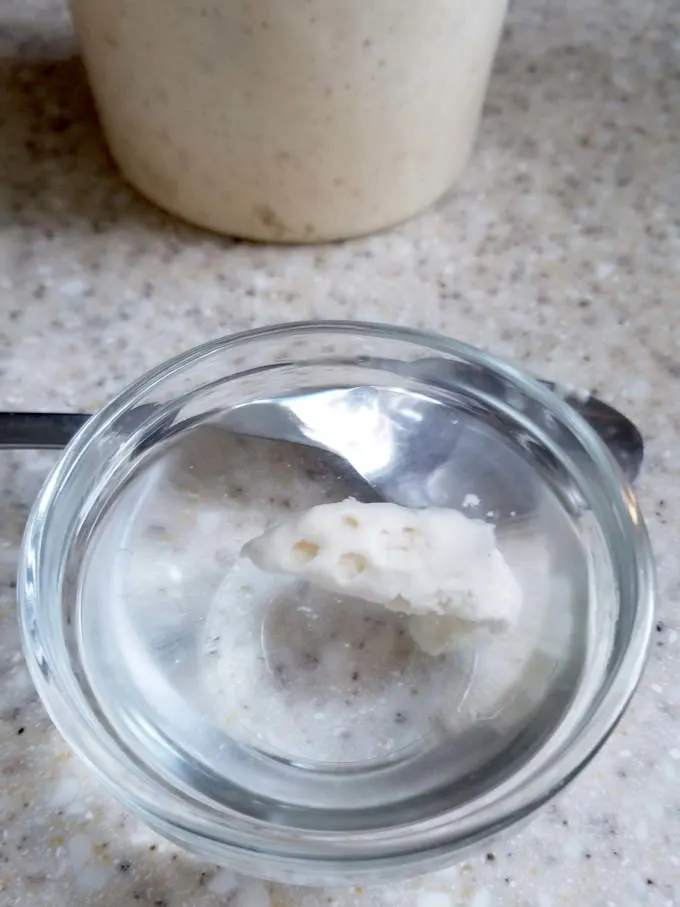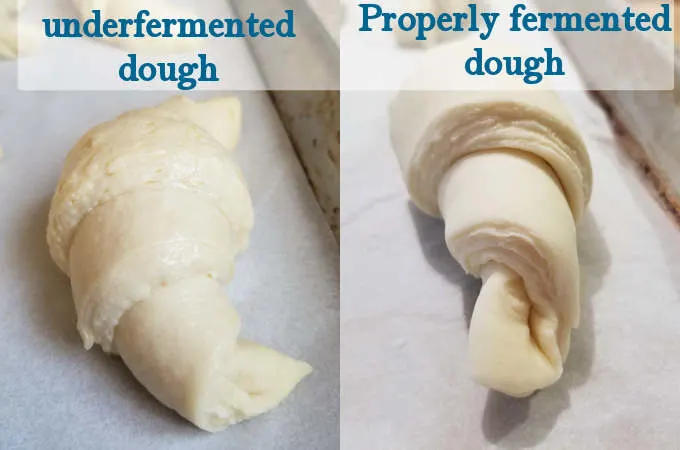Sourdough Croissants
These Sourdough Croissants are the best croissants ever! To have fresh Sourdough Croissants for breakfast, refrigerate them overnight and bake in the morning.

The difference between Classic Croissants and Sourdough Croissants is the use of the natural yeast in the starter to rise the dough. (You can use a smidge of commercial yeast to help you out, more on that later.)
If you don’t have one, check out my post to learn How to Make a Sourdough Starter. Then check out my system to Feed and Maintain Sourdough Starter. In the meantime you can go ahead and make those Classic Croissants with yeast.
I baked over 100 Sourdough Croissants before I was ready to post the recipe. The basic ingredients were not hard to nail down, I simply replaced some of the water and flour in the dough with sourdough starter and removed the yeast.


The biggest hurdle was keeping the dough warm enough to stay active, but not so warm that the buttery layers melt out of the dough. Well, that’s the challenge with any croissant recipe, but when working with sourdough is even more of a challenge.

What’s the secret to great Sourdough Croissants?
After several less than stellar batches, I finally decided that I had to treat this dough differently than classic croissant dough. Normally I would chill the dough after it’s mixed and chill it between each “turn”.
The problem with using that classic method is that each time I refrigerated the dough I slowed down the activity of the natural yeast and I could never get quite the poof I wanted in the final rise.
The first change I made was to add a hint of commercial yeast to the dough. Just a 1/2 teaspoon to help the dough stay active, but not so much that it would overtake the natural yeast or speed up the process too much. ***(See recipe note to make the recipe without commercial yeast.)
After 3 hours of fermentation the dough was beautifully soft, yet resilient. So I decided to skip the refrigeration step and move right into the lamination process.
Because the dough was soft, I let the butter warm up enough that it was a bit pliable, but still cool. This made it easier to roll the dough without the butter breaking apart.
Since the dough was so easy to work with I went right ahead and did the first two turns. I gave the dough a quick chill before the final turn and then a longer chill before rolling and cutting the dough.
Not only did this process cut a couple of hours from the total time, it also meant that my dough stayed nicely active. The dough was silky and alive. A good sourdough should feel alive in your hands.
The final step was to refrigerate the croissants overnight. In the morning I got up super early (the dogs help me here) and took the croissants out of the refrigerator.
Because my kitchen can be quite cool on a winter morning, I turned the oven on just for a minute to barely warm it up then turned it back off. (I wouldn’t need to do this in the summer.)
I put the trays in the oven and went back to bed (I’m not a morning person). When I got up a few hours later the croissants were ready to bake as soon as the oven was preheated.


Tips for making Sourdough Croissants:
- Your sourdough starter should be active when you mix the dough. It should pass the “float test”. Put a dollop of the active starter in water and it should float. If not, replenish your starter and wait until it’s active to mix the dough.
- If your kitchen is very cool, place the dough over a bowl of warm water or into a barely warmed oven during the fermentation time.
- If you find the butter is melting at any point during the lamination process, put in the the refrigerator briefly to chill.
- Brushing the dough with cool water before each fold helps create steam as the croissants bake. The steam will push the layers even higher for a bigger rise and flakier texture.
- The times in the recipe are estimates. The actual times will vary based on how active your starter is and the ambient temperature. The times will also be longer if you choose not to use the commercial yeast.

Over 100 croissants later, I can tell you that Sourdough Croissants have a depth of flavor that sets them apart from those made with commercial yeast. If you have a sourdough starter, I’m sure you know what I mean.
I know you hate to throw away that sourdough discard. Check out these recipes that use sourdough discard.
Are you a chocoholic? Me too. Use this dough to make decadent and delicious Chocolate Croissants. You’re welcome!
I’ve also got a recipe for almond lovers, Almond Filled Croissants are a little decadent and a lot delicious.
If you love this recipe as much as I do, I’d really appreciate a 5-star review.
Overnight Sourdough Croissants
Ingredients
- 8 oz active sourdough starter (1 cup, 100% hydration)
- 10 oz whole milk (1 ¼ cups, scalded and cooled to 110 °F)
- ½ teaspoon dry yeast (optional, see note)
- 17 ½ oz unbleached all purpose flour (3 ½ cups, see note)
- 3 oz granulated sugar (⅓ cup)
- 2 teaspoons table salt
- 16 oz unsalted butter (pliable but still cool)
- 1 egg (for egg wash)
Instructions
- Make sure your starter is active and bubbly before using. If not, refresh the starter and wait until it's fully active before mixing the dough. Place 8 oz active sourdough starter, 10 oz whole milk, ½ teaspoon dry yeast (if using) and 2 cups (10 oz) of the flour in the bowl of a stand mixer with the paddle attachment. Mix to form a thick batter. If working by hand mix with a wooden spoon. Cover the bowl and let it rest for 30 minutes.
- Switch to the dough hook. Add 3 oz granulated sugar, 2 teaspoons table salt and remaining flour. Mix until the dough gathers on the hook and clears the sides of the bow, about 3-5 minutes on medium speed. l. If working by hand stir in as much flour as you can with a wooden spoon, then finish kneading in the rest of the flour by hand.
- Transfer the dough to a lightly oiled bowl, turning once to coat the dough. Cover the bowl and set it aside at room temperature. After 30 minutes uncover the bowl, lift one side of the dough over into the middle of the dough. Repeat with the other three sides of the dough then flip the dough over. Cover the bowl and after 30 minutes repeat the procedure. Cover the bowl and after 60 minutes repeat the procedure. Cover the bowl and after 60 minutes repeat the procedure one last time. By now the dough should be lively, elastic and airy. If the dough is still sluggish give it another hour or two at room temperature.
- While the dough is fermenting, prepare the butter package. Draw an 8" square in the center of a piece of parchment paper. Flip the paper over and set 16 oz unsalted butter in the middle of the square. Fold the parchment over the butter. Use a rolling pin or other heavy object (I use the flat side of a meat tenderizer) to flatten the butter to fill the 8"x 8" square. You can lift the paper if it sticks. Trim and rearrange the edges of the butter as needed. Fold the butter into the parchment and place in the refrigerator. 30 minutes before the dough is finished fermenting, remove the butter from the refrigerator. (If your kitchen is very warm, take the butter out 10 minutes ahead.) The butter should be firm and cool but a little flexible for layering into the dough.
- Turn the dough out onto a lightly floured surface. Do not knead out the air. Roll the dough to a 10" square. Once you have a square, roll from each of the four sides to form a 3" flap of the dough, leaving the center thicker than the flaps. You should end up with a square with four "flaps" coming out from the corners. Now it’s time to layer in the butter.
- Unwrap the butter and place it in the middle of the square. Fold the flaps so they overlap and enclose the butter, pinching in the corners as necessary to glue the seams together. You should now have an 8" square of dough with the butter enclosed. Use the rolling pin to gently press on the square to flatten it. Roll the dough to a 8" x 24" rectangle. Take your time to roll gently and evenly so the butter stays in one layer in the dough.
- Orient the dough so the long side of the rectangle is facing you. Brush off the excess flour. Brush the entire surface of the dough with cold water. Fold the right 1/3 of the dough towards the middle then fold the left 1/3 of dough over enclosing it like a letter. This is the first "turn".
- Orient the dough so the closed edge is on the top side and the open edge is facing you. Roll the dough again to an 8" x 24" rectangle. Brush off the excess flour. Brush the entire surface of the dough with cold water and again fold the dough like a letter. This is the second "turn". Set the dough on a sheet pan, cover with plastic and refrigerate at least 30 minutes.
- Remove the dough from the refrigerator and do a third turn exactly like the first 2. Wrap the dough and place it in the refrigerator for at least 2 hours.
- Line 2 baking sheets with parchment paper or a silicone baking mat. Roll the chilled dough to a 24” long x 16” wide rectangle. With the long side facing you, fold the top half of the dough over the bottom half to form a 24” long x 8” wide rectangle.
- Starting from the left, measure along the top edge of the dough and make a mark at 2”. Using a pizza cutter or sharp knife, make a diagonal cut from that mark to the bottom left edge of the dough. Save the piece that you cut off.
- Working from left to right, measure and mark 4” increments along the bottom edge of the dough. Working from left to right, measure and mark 4” increments along the top edge of the dough. You should have a pattern of one top mark between two bottom marks. Starting from the top left, make a diagonal cut to the next mark on the bottom edge, forming a triangle. Then cut from the bottom to the next top mark. Continue this pattern to cut 11 alternating triangles and one 1/2 triangle end piece. Save the 1/2 triangle piece you cut from the end of the dough.
- Unfold the triangles and cut each in half along the joint so you have a total 22 triangles. Unfold the 1/2 triangle pieces which you cut from either end. Pinch them together to form 2 more triangles.
- To form a croissant, hold a triangle from the wide base in one hand and gently stretch the width a little. Set the dough on the work surface with the narrow end pointing towards you. Roll the croissant towards the pointed end, holding on to the tip and gently tugging as you roll. Bend either end of the croissant towards the middle to form the crescent shape.
- Set the croissants on the prepared baking sheets, 3” apart. You should fit a dozen croissants per half sheet pan. Cover with plastic wrap and set in the refrigerator overnight. (see note)
- In the morning. Take the croissants out of the refrigerator. Allow them to proof at room temperature for 2-3 hours. The exact time needed for proofing will vary depending how active your starter was and the temperature of your kitchen. They should be at least 50% larger than they started and feel airy and puffy. Preheat the oven to 400 °F. Brush the croissants with egg wash. Bake the croissants until golden brown, 15-20 minutes. Serve warm or room temperature.
Would you like to save this recipe?
As an Amazon Associate and member of other affiliate programs, I earn from qualifying purchases.









Thank you so much for sharing your recipe. I made a half batch and I was not keeping my hopes up bc the recipe had many steps and I didn’t get the timing right. I had to give the dough a lot of breaks since I had things to do. But they actually turned out!!! I’m trying the bagels next which seem much less complicated. 🙂
Yes, there are a lot of steps for making croissants. Nothing difficult, just a lot of steps.
Hi, I love sourdough! I bake everyday and make all different types of sourdough products. The one recipe I was looking for was croissants and then I came across your site. I have made these croissants 2x with slight modifications. My husband and children loved them! We are vegan, so we used soy milk and vegan butter for the dairy products and I used a oil wash instead of an egg wash. These are so good! We are now going to make your english muffins. Thank you so much for all of your hard work writing up these recipes and trying them out in your kitchen first. So much appreciated!
Thanks so much for the feedback Michele. If you haven’t tried them yet, I highly recommend the Sourdough Donuts!
Eileen,
I am interested in trying your recipe, as I am currently experimenting with sourdough croissants. I have a question regarding the actual hydration rate of the recipe. In one of the comments above, you state that it is around 57%, but my calculation show a value of 68%. The total flour content is 602g (490g flour + 112g flour in the sourdough starter) while the liquid content is 412g (300g milk + 112g water in the sourdough starter). I therefore have a hydration rate of 412/602, that is 68%. This is a much higher value than in any other croissant recipe (sourdough or not) I have seen. For instance, the current recipe I follow has 56% hydration, which is pretty typical. Is your recipe Indeed as hydrated as my calculation show or is there a mistake in the flour/liquid quantities? The posted video shows a dough that certainly looks more hydrated than the one I currently work with, but I want to be sure that I have everything right before I try your recipe. Thank you for clarifying.
Hi Frank, The whole milk in the recipe is about 87% water, not 100%. So my calculation is total flour 602g and total water is 355g (112g from starter and 243g from milk). 355/602 = 58%.
Eileen,
thank you for responding so fast! Regarding the whole milk quantity, 87% of 300g is 261g, so it seems that the total water content of the recipe is actually 373g (261 + 112), not 355g. This results in a hydration rate of 373/602 = 62%. This seems consistent with your dough looking more hydrated than mine without looking super wet. Am I correct?
If working by weight (milliliter is a volume measure) I use a conversion of 28g per ounce. 10 oz of milk would be 280g. 280x.87=243. Also, as far as the texture of the dough, don’t forget to consider the sugar. Depending on how much sugar is in your recipe that could account for a textural difference too.
Eileen,
I apologize for being picky, but the 1 1/4 cup (10 oz) of whole milk in the recipe weighs much more than 280g. 1 1/4 cup of water (10 oz or 300 ml) weighs exactly 300g, but milk has a higher density than water so the weight for the corresponding volume of milk is actually around 302g, Please check the following site for actual measurements:
This means that the actual hydration rate for your recipe has to be closer to 62% than to 58%. I have to get it right in order to try replicating your very nice croissants. Anyway, I’ll give it a shot based on this 62% hydration rate guesstimate and will let you know how it goes. Thank you!
Ok.
Calculating the hydration rate would have no influence on the recipe itself. Why did you say you had to know exactly the hydration rate so that you could try to make them?? That makes no sense?? You sound like you just wanted to correct her for no other reason than you want to be right.
Hello Eileen, and thank you very much for this wonderful recipe, I’d been looking for the recipe of sourdough Croissants for quite a while, then came across yours and realized that for the first time I am not questioning the method. Baked them today, and very happy with the result. One question though: the dough came out pretty dense (granted, I am a tartine person and would rather work with high hydration dough). Used KA all purpose flour. Is it supposed to be dense? Should I add a bit more milk next time (and there will be next time, definitely)? Thank you very much!
Did you work by weight or by volume measure? I also use KA all purpose flour. If you watch the video you can get a sense for the texture of the dough. It becomes lighter as it ferments, but I wouldn’t call it a “dense” dough. As you know there are variables based on how active your starter is, the hydration of your starter (I replenish my starter with equal weight water/flour so it’s 100% hydration). If you look strictly at the milk and flour in the recipe, it’s about 57% hydration, which is less than the 75% you’ll see in a Tartine recipe. But there is also sugar in the dough, which is a tenderizer. I find super high hydration dough a bit harder to work with and with the lamination process I prefer to have a less wet dough. I’m pretty happy with the texture, but you could certainly experiment with adding a bit more milk. If you do, let me know how it works out. I love to hear about recipe testing.
Thank you for the quick reply. I went by volume though normally would go by weight. I keep my starter at 50% hydration, but for the croissants I fed 40 g of starter with 100 ml of water and 100 g of flour and kept it overnight on the counter. I guess next time I will increase the hydration of the starter to get it to 100% and weight ingredients. Might get away without adding more milk. Will definitely let you know the outcome.
Eileen, Can these be made without sourdough starter? If so, how does the recipe differ. I assume the technique remains the same. Thanks.
Hi Judy. You can replace the 8 oz of starter with 4 oz of water and 4 oz of flour and increase the yeast to 1 packet. The timing will be a bit different since a dough made with commercial yeast will work faster. Instead of a 3 hour fermentation, just let the dough rise until doubled. You can still allow the formed croissants to rise over night in the refrigerator, but they may rise a little faster in the morning.